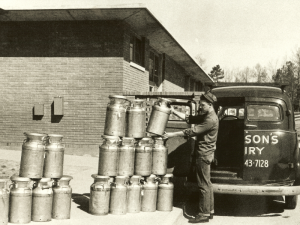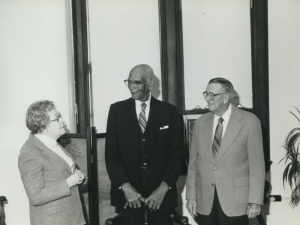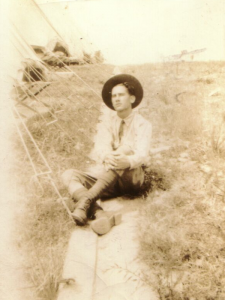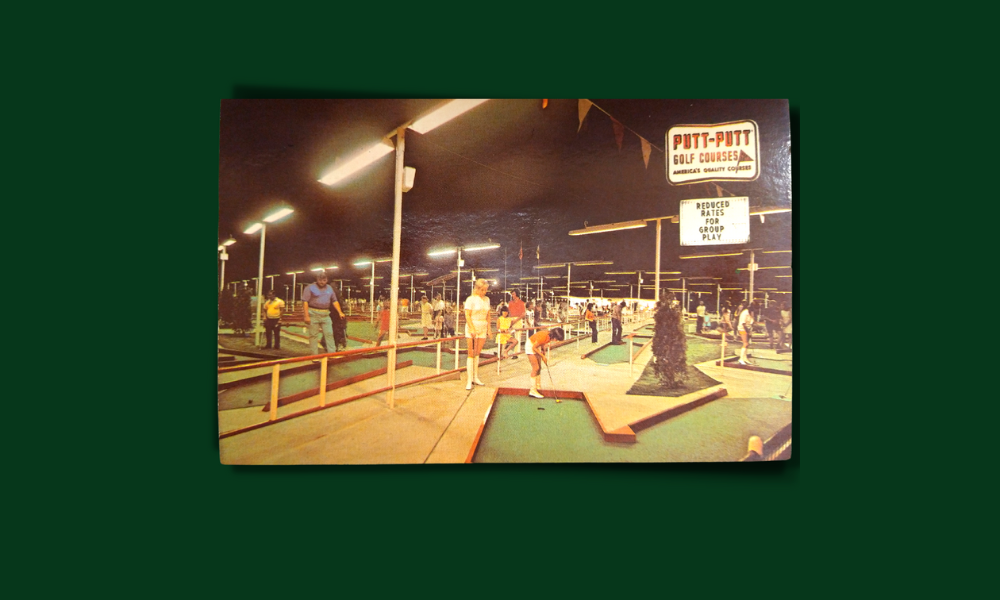“But This is My Version:” What Oral History Can Teach Us About DeKalb, Past and Present
Oral history and how we remember DeKalb County’s shared past.
By Kathryn Turnbull, Archives Assistant
How long have you lived in DeKalb County? What do you remember about DeKalb from years ago? What things will you remember about today’s DeKalb in fifty years? In the early 1980s, then-president of the DeKalb Historical Society James MacKay had the idea to ask these questions of longtime DeKalb residents in the historic courthouse before an audience and to record the incredible stories that came pouring out for later generations. Dubbed the “I Remember Hour (IRH),” the series would go on for nearly twenty years, documenting the lives and memories of DeKalb County’s public servants, business owners, educators, grandparents, and neighbors. Many of the folks who were interviewed at the close of the twentieth century were able to recall details of the DeKalb of their youth that are almost unbelievable to today’s residents; for example, did you know that there were once 57 dairy farms between Panthersville Road and Decatur Square? (Mathis Dairy IRH, 7) Or that, in 1928, there were 12 grocery stores within a one-block radius of the Square? (Andy Robertson IRH, 5)
Simpson’s Dairy Delivery to Tucker School
The DeKalb History Center’s foray into oral history did not end with the “I Remember Hour.” Far from it, in fact. These days, Safiyyah Shahid teaches at the Mohammed Schools of Atlanta, where she has worked for close to forty years. But as a young student at Spelman, she found a job through her church community as a babysitter for none other than Martin Luther and Coretta Scott King. Shahid spoke with DHC’s Marissa Howard earlier this year about her experience working for the King family:
“I came in the afternoon, early evening, to, you know, sort of bathe the children, lay their clothes out, make sure they got their pajamas on, lay their clothes out, get them ready for the next day. But Mrs. King, she didn’t play. She didn’t. [. . .] But she loved that Dr. King, though. She loved that man, and she would call him ‘Murton,’ that’s how she pronounced his name, ‘Murton.’” (Safiyya Shahid 2022, 11)
Shahid’s recollection of the King family is invaluable. Newspapers clippings do not reveal the dynamics within a family home, photographs cannot capture every waking moment, and autobiographical works opt to leave out the mundane. Shahid’s poignant memories demonstrate how oral history interviews are capable of showing us a different, more personal side of history that we don’t always get to see.
I Remember Hour with Reverend Ernest Moore
Oral history, of course, is not some all-encompassing, flawless medium. The stories shared are based on memories, which are both highly subjective and prone to falter as the memories, and the individuals who hold them, age. As historians, however, we know that history has no “perfect medium,” no omnipotent narrator, to tell some objective universal truth about the past. That is precisely where our work begins. We want to find out the locations and proprietors of those bygone dairies and groceries, the communities which they served, and how they impacted the region. The verification process is not always simple, and the record often contradicts itself; If you’ve ever been caught in an argument with a family member about the year some distant relative was born, or noticed how the family name adds or drops an “e” at the end every decade or two, then you’re familiar with how even the most basic information can be complicated. In search of these truths, we often go down rabbit holes inside of other, larger rabbit holes. But by piecing together memories, maps, letters, photographs, and more, we are synthesizing a version of the past that is more complete than one source alone can give us.
The origins of oral history as a method are vast. It would be impossible to put a date on the first instance of the oral tradition, or the sharing of history and memory through storytelling or by word of mouth, taking place. Oral transmission of knowledge and experience has been vital to diverse societies for millennia. Before the popularity of written language or widespread literacy, history needed to be passed down, directly, from one generation to the next, through communal and ritual storytelling. (University of British Columbia, First Nations and Indigenous Studies) Oral history as a modern academic field, however, began in the twentieth century, accelerated by the invention of audio recording. In 1948, the term “oral history” was coined by Allan Nevins of Columbia University upon the undertaking of a new project “for recording, transcribing, and making available to researchers the thoughts of persons believed to have information of value to historians.” (Coleman, The American Archivist, 1965) As the practice gained respect and influence, oral history programs were introduced across academic institutions, state and local historical societies, and independent archives. By 1967, The practice had become so essential to the fields of history and historic preservation that a national association was founded. The Oral History Association, now over fifty years old, works to establish standards, clarify ethics, contemplate archival methods, and define access and interpretation of oral history collections. (OHA)
I believe oral history is a fantastic place to start one’s research because it centers human experiences of places, movements, organizations, and other people, adding nuance, depth, and color to the historical landscape. Aside from the preliminary questions that interviewers come prepared with, oral history is spontaneous and unpredictable, leading to unexpected discoveries and unrealized connections. When original audio is available, the recordings also capture the accents, timbre, inflection, and vocal color of the storytellers themselves, offering further anthropological evidence. Transcription (frequently made possible by DHC volunteers, including Claudia Stucke) allows for increased searchability, comprehension, and accessibility of the material. The beauty of quality oral history transcription is that it does not care about maintaining academic voice or correcting grammatical errors—authenticity reigns supreme.
Ira B. Melton, Biloxi
I’ll end this love letter to oral history by quoting another interviewee, this time from the “I Remember Hour” series. Perhaps self-consciously, Pine Lake resident Ira B. Melton reminded the audience during his hour that, “anything that I say will be something the way I remember it. So if you go to the documents [. . .] , it might be a little different. But this is my version.” (Ira B. Melton, 2) In other words: trust, but verify. We are all only capable of telling our version, our experience, our history. We should look to oral history as one of the most enduring practices of turning individual memories into collective (but not always cohesive) histories.









